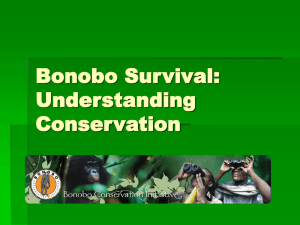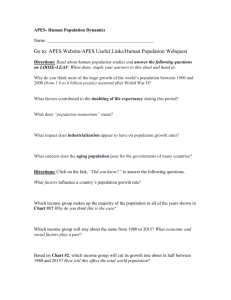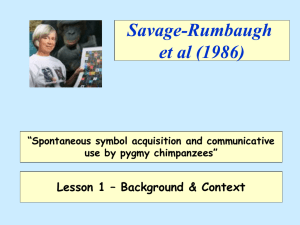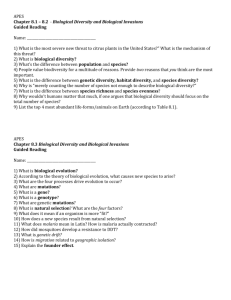Do Apes Use Language
advertisement
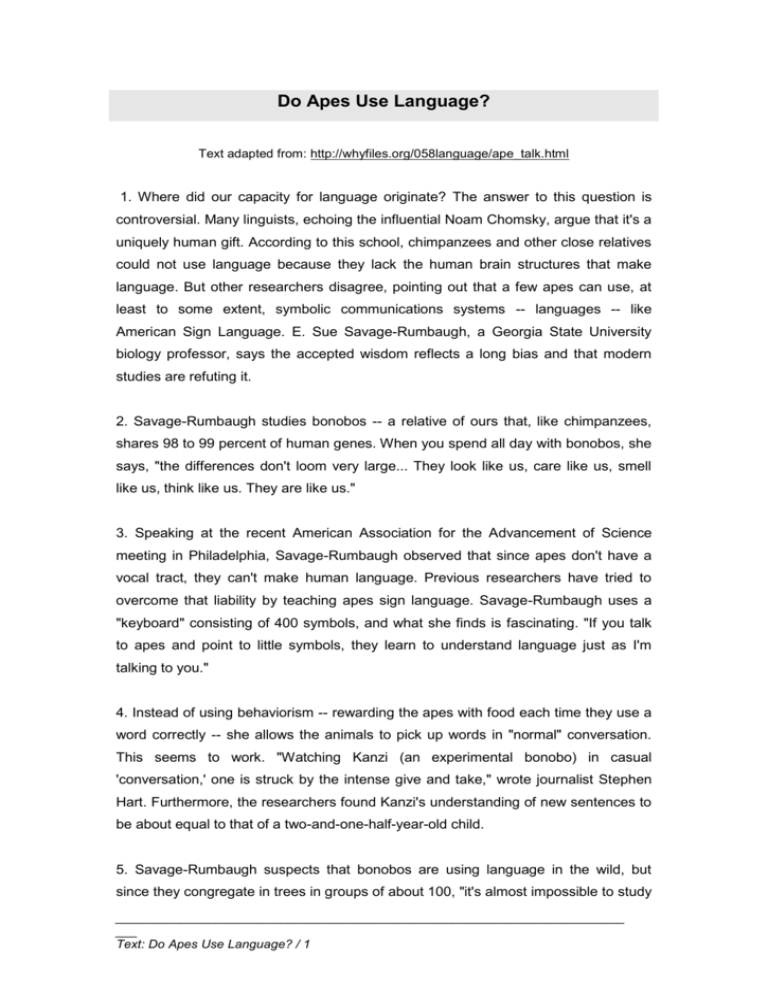
Do Apes Use Language? Text adapted from: http://whyfiles.org/058language/ape_talk.html 1. Where did our capacity for language originate? The answer to this question is controversial. Many linguists, echoing the influential Noam Chomsky, argue that it's a uniquely human gift. According to this school, chimpanzees and other close relatives could not use language because they lack the human brain structures that make language. But other researchers disagree, pointing out that a few apes can use, at least to some extent, symbolic communications systems -- languages -- like American Sign Language. E. Sue Savage-Rumbaugh, a Georgia State University biology professor, says the accepted wisdom reflects a long bias and that modern studies are refuting it. 2. Savage-Rumbaugh studies bonobos -- a relative of ours that, like chimpanzees, shares 98 to 99 percent of human genes. When you spend all day with bonobos, she says, "the differences don't loom very large... They look like us, care like us, smell like us, think like us. They are like us." 3. Speaking at the recent American Association for the Advancement of Science meeting in Philadelphia, Savage-Rumbaugh observed that since apes don't have a vocal tract, they can't make human language. Previous researchers have tried to overcome that liability by teaching apes sign language. Savage-Rumbaugh uses a "keyboard" consisting of 400 symbols, and what she finds is fascinating. "If you talk to apes and point to little symbols, they learn to understand language just as I'm talking to you." 4. Instead of using behaviorism -- rewarding the apes with food each time they use a word correctly -- she allows the animals to pick up words in "normal" conversation. This seems to work. "Watching Kanzi (an experimental bonobo) in casual 'conversation,' one is struck by the intense give and take," wrote journalist Stephen Hart. Furthermore, the researchers found Kanzi's understanding of new sentences to be about equal to that of a two-and-one-half-year-old child. 5. Savage-Rumbaugh suspects that bonobos are using language in the wild, but since they congregate in trees in groups of about 100, "it's almost impossible to study _______________________________________________________________________ ___ Text: Do Apes Use Language? / 1 them." And on the ground, they are silent to avoid predators. Despite the difficulty of researching bonobos in the wild, Savage-Rumbaugh has found that wild bonobos -only an estimated 4,000 to 40,000 survive in Congo, formerly Zaire -- have a second communication system. This one resembles road signs built of smashed plants rather than steel. The finding grew from the observation that troops of bonobos hang out in various locations during the day. When bonobos go foraging on the ground, the small groups must maintain "radio silence" to evade predators. Savage-Rumbaugh began wondering how one group manages to follow another to the next hangout. 6. In 1995, Savage-Rumbaugh spent two months studying bonobos at a research station operated by Takayoshi Kano, a Japanese primate researcher in the Congo forest. During two days of following troops with local bonobo trackers, she observed that their trails were clearly marked by smashed plants and branches planted at an angle to the direction of travel. 7. Although some skeptics counter that she was just seeing trampled plants, she contends they actually were road signs since they occurred only at trail intersections. "These clues are not left at arbitrary points in the vegetation but rather at locations where trails split and where an individual following might be confused as to the correct direction to take." 8. Thus in swamps, where plenty of footprints mark the trail, the road signs are not needed and not seen. While the finding has not been replicated in other primates, Savage-Rumbaugh suspects that it does represent the kind of symbolic communication system humans rely on. "This is the first time that anyone has tried to say that this altered vegetation is communicating anything." _______________________________________________________________________ ___ Text: Do Apes Use Language? / 2 Exercises adapted from Dr. Anna Lyubman Do Apes Use Language? I. Pre-Reading Read the following joke, and then discuss the answers to the questions that follow. A guy sees a sign in front of a house: "Talking Dog for Sale." He rings the bell and the owner tells him the dog is in the backyard. The guy goes into the backyard and sees a black dog just sitting there. "You talk?" he asks. "Yep," the dog replies. "So, what's your story?" The dog looks up and says, "Well, I discovered this gift pretty young and I wanted to help the government, so I told the CIA about my gift, and in no time they had me jetting from country to country, sitting in rooms with spies and world leaders, because no one figured a dog would be eavesdropping. I was one of their most valuable spies eight years running. The jetting around really tired me out, and I knew I wasn't getting any younger and I wanted to settle down. "So I signed up for a job at the airport to do some undercover security work, mostly wandering near suspicious characters and listening in. I uncovered some incredible dealings there and was awarded a bunch of medals. Had a wife, a few puppies, and now I'm just retired." The guy is amazed. He goes back in and asks the owner what he wants for the dog. The owner says, "Ten dollars." The guy says, "This dog is amazing. Why on earth are you selling him so cheaply?" The owner replies, "He's such a liar. He didn't do any of that stuff." Why did the guy in the joke say that the dog was amazing? What surprised him so much? Why was the dog owner selling the dog so cheaply? Questions for Discussion 1. How do animals communicate? 2. Do you have a pet? How do you communicate with your pet? 3. Can you name any movies, cartoons, or books that depict talking animals? Why do you think animals are often attributed an ability to speak? 4. Can animals be taught to talk? _______________________________________________________________________ ___ Text: Do Apes Use Language? / 3 II. Comprehension Questions 1. In paragraph 1, the writer brings the view of E. Sue Savage-Rumbaugh, who says that “the accepted wisdom reflects a long bias and…modern studies are refuting it”. a. What view about language is disproved by modern research? ________________________________________________________________ b. What is the reason for this view? ________________________________________________________________ 2. What are bonobos? (Complete the sentence.) Bonobos are a type of (ONE WORD) ________________________________ 3. a. What is the “liability” that researchers have tried to overcome in apes (paragraph 3)? ________________________________________________________________ b. What is the reason for this liability? ________________________________________________________________ 4. (Paragraph 3) What specific method does Savage-Rumbaugh use to communicate with apes? ________________________________________________________________ 5. a. What is “behaviorism”? ____________________________________________ b. Does Savage-Rumbaugh use behaviorism? YES / NO c. Which word helped you find the answer? (ONE WORD) __________________ 6. a. Who is Kanzi? __________________________________________________ b. What approach to language learning is illustrated by the example of Kanzi? ________________________________________________________________ 7. Complete: Kanzi’s understanding of new sentences is similar to ________________________________________________________________. 8. Why is it difficult to study the language of bonobos in the wild? List two reasons. a. ______________________________________________________________ b._______________________________________________________________ 9. (Paragraph 5): What is Savage-Rumbaugh’s finding about the bonobos’ communication system? (Complete the sentence below to explain the finding.) The bonobos' communication system is similar to the human system of _______________________________. However, whereas the bonobos’ system uses _____________________, the human system uses __________________. _______________________________________________________________________ ___ Text: Do Apes Use Language? / 4 10. For what purpose do bonobos use their communication system in the wild? Complete: To help ___________________ find the way to _________________. 11. a. Do all researchers share Savage-Rambaugh’s view on how bonobos use their second communication system? YES / NO Quote from the text to support your answer. _____________________________ ________________________________________________________________ b. How does Savage-Rambaugh justify her point of view? a. Smashed plants only appear at confusing points on the path. b. Bonobos always leave their marks at arbitrary locations. c. Clues that are left by bonobos look like human road signs. d. Bonobos mostly leave their signs in swamps, together with footprints. 12. (Paragraph 8) How do bonobos find their way through swamps? ________________________________________________________________ 13. What is the implication of Savage-Rambaugh’s study in the Congo forest? a. It is possible to teach animals to use human language. b. Bonobos can use systems of communication similar to people’s. c. It is the first time that anyone has claimed that vegetables can talk. d. Apes cannot use language since they lack human brains. III. Post-Reading Group Activity: Now you have a chance to learn more about animal communication. Work in groups. Read the following examples and fill out the table below with the information about the different animals. Kanzi Dr. Sue Savage-Rumbaugh is a researcher who strongly believes in the ability of primates to use language. One of her most impressive observations involved a bonobo chimpanzee named Kanzi. Savage-Rumbaugh tried with no success to train Kanzi's adoptive mother to use a keyboard of symbols. The researchers were surprised to find that Kanzi had been listening to his mother's lessons and had acquired a substantial vocabulary. From then on, Kanzi was not given structured training like his mother, but was taught while walking through the forest with his trainers. By the age of 6, Kanzi had acquired a vocabulary of 200 words and was able to construct sentences by combining words with gestures or with other words. Kanzi's most notable accomplishment was captured on videotape: he was told, "Give the dog a shot," and he proceeded to inject his stuffed dog with a syringe. Savage-Rumbaugh argues that once Kanzi mastered a substantial vocabulary, he could respond _______________________________________________________________________ ___ Text: Do Apes Use Language? / 5 accurately to 70% of new commands. Critics say that Kanzi's accomplishments are not proof of language ability in primates because the crucial element in language ability is production, not comprehension. Adapted from Lauren Kosseff, downloaded from: http://www.pigeon.psy.tufts.edu/psych26/language.htm Washoe Washoe is a chimpanzee who was taught to sign by her caretakers, Allen and Beatrice Gardner. She was raised in a friendly environment in which she learned sign language both through imitation and instrumental learning. Her language acquisition was notable in several respects. Washoe was able to transfer signs to a new object without specific instruction. For example, she learned the word "more" in relation to tickling but was spontaneously able to apply the term to another object. Additionally significant was Washoe's use of signs in combinations after learning only about 8 or 10 signs. This spontaneous combination of signs seems similar to the ability of human children to connect words in sentences to which they have never specifically been exposed. Washoe has demonstrated reliable use of 240 signs. Her trainers have observed that Washoe mostly uses her signs to discipline her children and explain her concern about them. Adapted from Lauren Kosseff, downloaded from: http://www.pigeon.psy.tufts.edu/psych26/language.htm Nim Animal researcher Herb Terrace doubted that primate language was any sort of equivalent of human language, and he did not believe that the findings of language acquisition and use in Washoe and other primates truly indicated language acquisition. Instead, he believed that there were other explanations for the behavior that had been considered primate language use by other researchers (for example, he thought that primates only signed to please their trainers, not for the personal satisfaction of using the signs). Therefore, Terrace decided to conduct his own study of primate language use. He raised a chimpanzee, Nim, as a human child and taught him sign language in the manner in which Washoe had been taught. Nim did in fact demonstrate some important aspects of language use. He was observed using the signs for "angry" and "bite" to express his displeasure, an important observation in that it demonstrates the use of arbitrary symbols to represent physical actions. Despite his acquisition and _______________________________________________________________________ ___ Text: Do Apes Use Language? / 6 use of numerous signs, Terrace decided that Nim was incapable of combining words to create new ideas. The only occasions in which Nim produced combinations of signs were imitations of signs previously produced by his trainers. Adapted from Lauren Kosseff, downloaded from: http://www.pigeon.psy.tufts.edu/psych26/language.htm Phoenix and Akeakamai In a pool not far from Waikiki Beach, two female dolphins poke their heads out of the water, waiting for a command. "O.K.," says Louis Herman, founder and director of the Kewalo Basin Marine Mammal Laboratory, "now let's try a tandem creative." Two graduate students, positioned at opposite ends of the 50-foot tank, throw full body and soul into communicating this message to the animals, Phoenix and Akeakamai. First the humans ask the dolphins to pay attention by holding a finger high in the air. Then they tap the index fingers of each hand together, forming the gesture that has been taught to mean tandem. Next they throw their arms up in a gesture that means creative. The dolphins have just been told, "Do something creative together." The dolphins break away from their trainers and submerge in the 6-ft.-deep water, where they can be seen circling until they begin to swim in tandem. Once they are in sync, the animals leap into the air and spit out jets of water before jumping back into the pool. The trainers flash huge smiles at their pupils and applaud wildly. The animals also seem delighted and squeak with pleasure. What is going on here? Do the dolphins actually understand the command “tandem creative” as a request to make some artistic statement through movement together? Did they communicate in some fashion to choose a routine and coordinate their movements? In order to spit, for instance, they both must take water into their mouths before they leap into the air -- a trick that takes some forethought. Other requests for tandem creatives have produced a variety of results, including a backward swim ending in a wave of the tails. Or could it be that these routines are nothing more than one dolphin very closely following the lead of another? In the wild, after all, dolphins are extremely skilled at tuning their actions to the movements of others in their group. Adapted from:"Can Animals Think?" by Eugene Linden, Time, March 29, 1993 _______________________________________________________________________ ___ Text: Do Apes Use Language? / 7 Alex At the University of Arizona, Alex, the talkative African gray parrot, is, as usual, commenting on all he sees. "Hot!" he warns in a sweet, childlike voice, as a visitor picks up a mug of tea. Alex spots a plateful of fruit and announces his choice: "Grape." Everyone knows parrots can talk, but for the past 15 years, ethologist Irene Pepperberg has been working with Alex, exploring the extent to which the birds understand what they are saying. Pepperberg picks up an object from a tray and asks, "What toy?" Alex promptly answers, "Block." He then responds to questions about the plaything, describing its color, shape, what it is made of ("wood") and whether it is bigger or smaller than other objects on the tray. Something more than simple imitation seems to be at work in the case of this one pound bird. Alex also uses English to communicate what appears to be his feelings. After incorrectly answering how many rose-colored pieces of wool are mixed in with other objects on the tray, he says, "I'm sorry." A moment later the obviously frustrated bird says, "I'm gonna go away" and turns his back on the tray. Does Alex know what he is saying, or is "I'm gonna go away" merely a collection of sounds he says when frustrated? Adapted from:"Can Animals Think?" by Eugene Linden, Time, March 29, 1993 _______________________________________________________________________ ___ Text: Do Apes Use Language? / 8 Animal Achievement(s) Method used to teach / work with it Conclusions /Criticism/ Reservations Kanzi Washoe XXXXXX Nim Phoenix and Akeakamai XXXXXX Alex _______________________________________________________________________ ___ Text: Do Apes Use Language? / 9 IV. Vocabulary Study the following words as they appear in the article. Word Also in par. # Word Paragraph 1 Paragraph 4 1. capacity (n.) 13. reward (v./ n.) 2. originate (v.) origin (n.) 14. experimental (adj.) experiment (n./v.) 3. controversial (adj.) controversy (n.) 15. equal (adj.) 4. relative (n., adj.) Also in par. # 2 5. (to some) extent Paragraph 5 6. refute (v.) 16. suspect (v., n.) suspicion (n.) 8 8. reflect (v.) reflection (n.) 17. location (n.) locate (v.) 7 9. bias (n./v.) biased (adj.) Paragraph 7 Paragraph 3 10. observe (v.) observation (n.) 18. counter (v.) 6 5 19. contend (v.) 11. overcome (v.) Paragraph 8 12. consist of (v.) 20. rely (on) (v.) Exercise 1. Which words from the above vocabulary list mean the same as the emphasized words below? 1. Which word means the same as include / contain? _________________________ 2. Which word means the same as degree / amount ? _________________________ 3. Which word means the same as place? __________________________ 4. Which word means the same as argue / claim? _________________________ 5. Which word means the same as come from / begin? ________________________ _______________________________________________________________________ ___ Text: Do Apes Use Language? / 10 8 Exercise 2. Read and answer the questions below using your knowledge of the vocabulary words. The words in the bold print are from the vocabulary list. 1. How would you reward someone who saved your life? ________________________________________________________________ 2. Which relatives would you invite to your birthday party? ________________________________________________________________ 3. What would you do if you felt that your teacher was biased against you? ________________________________________________________________ 4. Give an example of nonverbal communication. ________________________________________________________________ 5. Do you agree that experiments on animals should be forbidden? Explain. ________________________________________________________________ 6. What controversial issue have you recently heard or read about? ________________________________________________________________ 7. Your friend tends to fall asleep in lectures. How would you recommend that s/he overcome this negative habit? ________________________________________________________________ 8. Which clues help you answer reading comprehension questions? Give an example._________________________________________________________ 9. In choosing a career, would you rely more on advice from your parents, your friends, or on your own intuition? Explain. ________________________________________________________________ 10. Do you agree with the view that boys and girls do not have equal capacities for math? Explain. ____________________________________________________ 11. How can you check if a person’s words reflect his real feelings? ________________________________________________________________ _______________________________________________________________________ ___ Text: Do Apes Use Language? / 11 Exercise 3. Words with multiple meanings A. Different forms of the word observe (v.) appear several times in the article with different meanings: in paragraphs 3, 5, and 6. Study .the following dictionary definitions of the word observe (v.) / observation (n.): 1. To see and notice, watch (v.) / something that one sees or notices; watching something (n.) 2. To pay attention to (rules, traditions, etc.) (v.) / paying attention to (n.) 3. To say something as one’s opinion, to remark (v.) / something someone says (n.) - Which meaning of the word is used in paragraph 3? ________________ - Which meaning of the word is used in paragraph 5? _______________ - Which meaning of the word is used in paragraph 6? _______________ Write three different sentences illustrating each of the three meanings of the word. You can either use it as a verb (observe) or as a noun (observation). ___________________________________________________________________ __________________________________________________________________ ___________________________________________________________________ B. The word suspect (v.) appears in paragraphs 5 and 8. Study the following dictionary definitions of this verb: 1. To have an idea or feeling concerning the possibility or truth of (something) (v.) 2. To have a feeling that a person may be guilty (of something) (v.) - Which meaning of this word is used in the article? _____________________ -The word suspect has 2 noun forms: suspect (n.) and suspicion (n.). Use your dictionary to fill in the correct meaning in Hebrew of each word below. 1. suspect (n. ) (________________________) 2. suspicion (n. ) (________________________) - Which noun forms of the word correspond to each of the verb meanings? (Circle the correct answer.) suspect = suspicion = definition 1 / definition 2 definition 1 / definition 2 Write two sentences illustrating each meaning of the word (as a verb or a noun). ___________________________________________________________________ ___________________________________________________________________ ___________________________________________________________________ Exercise 4. Easily confused words _______________________________________________________________________ ___ Text: Do Apes Use Language? / 12 A. The following two verbs are easily confused: 1. Count 2. Counter Which of them is used in the article? Find it in the text. B. Read the following two examples illustrating the meaning of each of the verbs. 1. Two little boys were playing hide-and-seek in the garden. One of them counted to ten and ran off quickly to look for his friend. 2. The opposition countered the government’s argument that taxes should be increased on import products. C. Fill in the blanks in the sentences below with the correct verb: counter or count. 1. When the schoolchildren got on the bus, their teacher ________________________ them to make sure that no one had gotten lost. 2. It is necessary to discuss ways to __________________________ racism all over the world. D. Notice that counter- can also be a prefix meaning ‘against’. Read the following example: The teacher found out that one student was cheating on the test. He decided to give her a zero hoping that this countermeasure would deter her from cheating in the future. Here are some other words with counter-. Can you guess their meanings? counterterrorism ________________________ counterproductive ___________________________ counterargument _____________________________ _______________________________________________________________________ ___ Text: Do Apes Use Language? / 13


